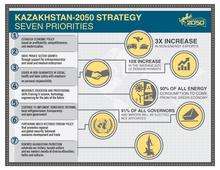Kazakhstan 2050 Strategy

Kazakh President Nursultan Nazarbayev announced the Kazakhstan 2050 Strategy (also called “2050 Strategy”) during his annual state of the nation address on December 15, 2012. The 2050 Strategy calls for widespread economic, social and political reforms to position Kazakhstan among the top 30 global economies by 2050.[1]
The 2050 strategy calls for the economic diversification of single-industry towns and the direct election of regional governors, which were previously presidential appointments.
Overall aims
The three key aims of the policy are: to define new markets where Kazakhstan can form productive partnerships and create new sources of economic growth, to create a favorable investment climate, and to develop an effective private sector and public-private partnerships.
Nazarbayev explained how these overall aims will be achieved through the application of the new policy to three key areas of macroeconomic policy and various sectors of the economy:
- Budgetary policy: The focus will be on long-term, national projects related to diversification of the economy and development of infrastructure; these will be selected based on feasibility and rate of return and must be as carefully managed as private sector investments. There will also be a renewed focus on building up reserves to provide a buffer against future global economic deterioration.
- Tax policy: The focus will be on stimulating internal growth, driving exports and encouraging saving and investment by individuals. The drive to simplify tax and customs administration and reporting will continue, and tax benefits will be made available to those involved in production and new technology sectors.
- Monetary and debt policy: Key tasks of the National Bank and the Government in this area will be to manage inflation while encouraging economic growth; to maintain public and quasi-public sector debt at moderate levels; and to reduce the budget deficit to 1.5% of GDP by 2015 (from the 2.1% expected in 2013). The plan also calls for Kazakhstan’s banks to meet private sector-demand for finance.
Seven priorities of the Strategy Kazakhstan-2050

A Kazakhstan 2050 Strategy website has been created.
1. Economic policy of the new course – all around economic pragmatism based on the principles of profitability, return on investment and competitiveness
- Universal economic pragmatism
- New personnel policy
- Modernization of the macroeconomic policy
- Budgetary policy
- Tax policy
- Monetary policy
- Policy of managing public and external debt
- Infrastructure development
- Modernization of the system of managing the state assets
- New system of managing natural resources
- Plan for the next phase of industrialization
- Modernization of the agricultural sector
- Development of farming and SME in agricultural processing and trade
- Policy regarding water resources
2. Comprehensive support of entrepreneurship – leading force in the national economy
- Development of small and medium enterprises
- New model of public private partnership: “Strong business – strong state”.
- New stage of privatization – changing role of the state
3. New principles of social policy – social guarantees and personal responsibility
- New Principles of Social Policy
- Minimum social standards
- Targeted social support
- Addressing social imbalances in the regions
- Modernization of the labor policy
- Protection of motherhood. Appeal to all the women
- Children’s rights
- Health of the nation is basis of our successful future
- Key priorities in healthcare
- New approaches in healthcare for children
- Improving medical education system
- Quality of medical care in rural areas
- Physical training and sports
4. Knowledge and professional skills are key landmarks of the modern education, training and retraining system
- Priorities in education
- Extending “Balapan” program until 2020
- Developing engineering education system
- Developing system of social responsibility in education
- Modernization of teaching methods
- New innovative research development policy
- Technology transfer
- Cooperation of science and business
- Roadmap of development prospective national clusters
- Appeal to the youth
5. Further strengthening of the statehood and development of the Kazakhstan democracy
- New type of state governance
- Improving system of state planning and forecasting
- Decentralization of power
- Dividing responsibilities and power between center and the regions
- Development concept of local self-governance
- Election of the rural governors
- Creating a professional state apparatus
- Second stage of the administrative reform
- New system of interaction between state apparatus and business community
- Introducing “zero tolerance” principle towards disorder
- Fight against corruption
- Reforming law enforcement bodies and special agencies
6. Consistent and predictable foreign policy is promotion of national interests and strengthening of regional and global security
- Foreign policy modernization priorities
- Development of economic and trade diplomacy
- Strengthening regional security
- Contribution to global security
- Strengthening national defense capacity and military doctrine
7. New Kazakhstan patriotism is basis for success of our multiethnical and multi-confessional society
- New Kazakhstan Patriotism
- Equality of citizens of all ethnic groups
- Kazakh language and three-side unity of languages
- Culture, traditions, and distinction
- Role of the national intelligentsia
- Religion in Kazakhstan of 21st century
- What Kazakhstan do I see in future?
- Appeal to the nation
The Kazakhstan Way: "One goal, One Interest and One Future"
President Nazarbayev's 2014 State of the Nation was given under the title of "Kazakhstan Way – 2050: One goal, One Interest and One Future".[2]
Primary features of "The Kazakhstan Way"
- Preserving Independence and the development of Astana;
- National unity, peace and accord in the society;
- Secular society and high spirituality;
- High economic growth achieved on the basis of industrialization and innovation;
- General Employment Society;
- Unity of history, culture and the language;
- National security and participation of our country in resolving global and regional problems.
Two stages of Strategy 2050
In his address, President Nazarbayev outlines the two stages of the 2050 Strategy. The first stage covers the period until 2030, during which Kazakhstan will make a modernization leap, similarly to South Korea and Singapore over the last fifty years. Kazakhstan will growth of traditional industries and create a processing industrial sector.[2]
The second stage, which covers the period from 2030 to 2050, will ensure sustainable development by emphasizing the knowledge economy, with high value added goods and a foundation of engineering services.[2]
Principles of the Strategy 2050 implementation
- Pragmatic decision making
- Incorporate the world’s best practices
- Improve the well being of Kazakh citizens
- Transparency and discussion with the public about implementation
10 top projects of 2050 Strategy implementation
In his address, President Nazarbayev outlined 10 projects to be implemented in the 2050 Strategy.[3][4]
- Public service transport in Kazakhstan will become more ecologically friendly. New infrastructure will be created for special electric cars to be used across the country.
- Kazakhstan is slated to build up nuclear power industry and construct nuclear power plants. Demand for cheap nuclear power is believed to grow rapidly in the years to come.
- Funding for science is to increase up to the level of 3% of GDP.
- Development of mobile and multimedia, nano- and space technologies, robotics technology, gene engineering, search and discovery of energy of the future is being eyed in Kazakhstan.
- An effective land market will be created through transparent pricing policy. Croplands will be leased out on condition that investments are attracted and new advanced technologies are introduced in order to increase competitiveness of Kazakshtani agricultural sector.
- Along with production of natural products, Kazakhstan will commence the development of short-rain genetically modified crops.
- A new oil refinery will be built in Kazakhstan.
- Kazakhstan will look into the possibility of introduction of compulsory health insurance. Shared responsibility of the state, the employer and the employee for his/her health is to become the major principle of the nationwide health care system.
- A new document underpinning the key values of Kazakhstani society - "The Mangilik Yel" (Eternal Nation) will be drawn up and adopted in the country.
- The Cultural Policy Concept is to be mapped out in Kazakhstan.
References
- ↑ "Kazakhstan 2050 Strategy Leads to Government Restructuring". Carnegie Endowment for International Peace.
- 1 2 3 "2014 State of the Nation address". KZ Embassy in the United States. Archived from the original on 2 February 2014.
- ↑ "10 sensational projects to be implemented in Kazakhstan – News Feed – Kazakhstan news today". Bnews.kz. Retrieved 2015-07-12.
- ↑ "Стратегия Казахстан 2050 - State-of-the-Nation Address by President of Kazakhstan Nursultan Nazarbayev". Strategy2050.kz. Retrieved 2015-07-12.